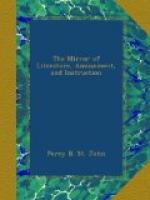[4] The passage to which our
kindly Correspondent refers is as
follows:
“The serpent, instead of being the emblem of
wisdom,
should have been an emblem of stupidity.”—See
Mirror,
vol. xviii. p. 343.
[5] See Mirror, vol. xviii. p. 356.
PHILAETHES.
Hereford.
* * * * *
THE BUSTARD.
The Bustard, huge Rasor, with gular pouch
long,
With legs formed for running, and beak
that is strong,
Whose presence this island regards now
as rare.
Jennings’s Ornithologia.
This bird is of the same order as the Dodo (the gallinaceous, cock or pheasant), figured and described at page 311. There are seventeen species, which form the genus Otis of Linnaeus. They are natives of Europe, Asia, and Africa. Their characteristics are—bill strong, a little incurvated; toes, three before, none behind; legs long, and naked above the knees. The specimen here figured is the Great Bustard, or Tarda, said to be the largest of British birds, sometimes weighing as much as thirty pounds. It is found in some parts of this country, and inhabits also the open plains of Europe, Asia, and Africa. Its colour is wave-spotted with black, and rufous; beneath, white; length, four feet; female not so large, weighing about twelve pounds: she has also different shades of colour. The male has a long pouch, (see the Cut), beginning under the tongue, and reaching to the breast, capable of holding several quarts of water—supposed to be for supplying the hen while sitting on the young. The cheek-feathers are elongated, so as to form on each side a sort of mustachio. It subsists on grains and herbs; it also feeds on worms and insects, and according to late observations, on rats and field-mice;[6] is solitary, shy, and timid; flies heavily, but runs swiftly; is




